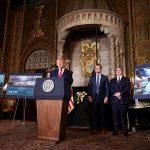The first skirmish in the US-China trade war just concluded and John Carney is left licking his wounds.
Canadian Prime Minister Mark Carney said his government will allow automakers to import US-manufactured cars and trucks without tariffs, as long as the companies continue to build cars in Canada, and continued with previously announced expansions. Which of course, they all will vow to do – after all, there is no downside to a promise – meaning Canada just conceded to a key Trump demands.
Last week, Carney put retaliatory tariffs of as much as 25% on vehicles made in the US, effectively matching an earlier move by US President Donald Trump on foreign autos.
The move provides relief from the trade war to companies including General Motors and Stellantis that have assembly plants in Ontario but still export large quantities of vehicles from the US into Canada.
Commenting on the capitulation, Rabobank’s Michael Every writes that “Canada will now let automakers import US-assembled cars and trucks tariff-free if they preserve domestic manufacturing. This isn’t being heralded as a Carney “retreat” and “fold”, of course. But in economic statecraft terms, it’s clear Canada had, and has, no real choice.“
“Our counter-tariffs won’t apply if they continue to produce, continue to employ, continue to invest in Canada,” Carney told reporters at a news conference. But if a manufacturer cuts production or investment in Canada, the number of tariff-free vehicles it will be permitted to import will be reduced, Canada’s Finance Department said in a news release.
François-Philippe Champagne, Canada’s finance minister, did not specify in his statement exactly how many U.S.-made cars and trucks each of the five major automakers would be allowed to import without tariffs. But his statement suggested that those numbers would be linked to Canadian manufacturing: “The number of tariff-free vehicles a company is permitted to import will be reduced if there are reductions in Canadian production or investment.”
While the great majority of Canadian-made cars and trucks end up in the United States, Trump has repeatedly said that he wants carmakers to move all of their manufacturing to the United States, a move widely seen in Canada as a direct assault on the country’s largest export aside from oil and gas.
Auto trade between the United States and Canada has become tightly integrated since the two countries signed a trade deal 60 years ago that eased the flow of vehicles and related goods across the border.
Only Toyota and Honda, which account for about two-thirds of Canadian auto production, are currently operating at or near full capacity in Canada.
Stellantis recently stopped renovating a factory in the Toronto suburb of Brampton that would have made gasoline and electric Jeeps, in what the company described as a pause. Its larger plant, in Windsor, Ontario, is in the middle of a two-week shutdown that was induced by the U.S. tariffs.
Ford’s factory in Oakville, Ontario, was closed for a now-abandoned plan to convert it for electric vehicles. It is now retooling to make large pickups. And General Motors announced that it would largely shut down production of a poor-selling electric van made in Ingersoll, Ontario, until October.
But the winning blow in this particular trade war battle came from Japanese media outlet Nikkei which reported that Honda Motor is looking at shifting some of its auto production from Canada and Mexico into the US, with a goal of having 90% of its US vehicles sales produced locally.
Honda currently builds CR-V and Civic vehicles at a plant in Alliston, Ontario, and last year it announced a C$15 billion ($10.8 billion) long-term plan to build out an electric-vehicle supply chain in Canada — with significant help from taxpayers.
Anita Anand, the industry minister, was scheduled to meet with the head of Honda’s Canadian division on Tuesday, according to a statement. “We are in close contact with the company, and Honda has communicated that no such production decisions affecting Canadian operations have been made, and are not being considered at this time,” her office said by email.
A Honda spokesperson said by email that the plant “will operate at full capacity for the foreseeable future and no changes are being considered at this time.”
Carney, currently campaigning for the national election on April 28, told reporters that he and other government ministers have had a number of conversations with the executives of global automakers.
“We are very seized with the issues” around the auto tariffs, Carney said, pointing to a campaign promise he made to set up a C$2 billion fund to help strengthen the Canadian auto supply chain. Whoever wins the election will need to negotiate with Trump on a broader strategy to resolve the tariff war, he said.
Canada currently has 25% counter-tariffs on about C$60 billion worth of US products, aside from autos. Those taxes are hitting a wide range of US steel and aluminum products, plus items such as tools, computers and consumer goods.
The exemptions announced Tuesday will provide a break to Canadian businesses that rely on US inputs, as well to institutions such as hospitals, long-term care facilities and fire departments, the government said.
Loading…











